|
|
| 'Like' us on Facebook | Follow us: |
Posted on: Feb 14, 2014
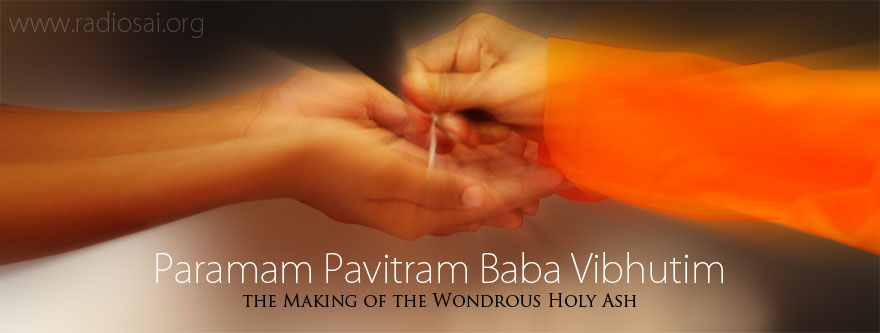 |
It is named Vibhuti since it endows one with prosperity; Bhasma - 'ashes' because it burns away all sins; Bhasitam - 'brightened' because it increases one's spiritual splendour; Ksharam - 'destruction' since it removes danger; and Raksha - 'protector' for it is an armour against the machinations of evil spirits. This is how the Vibhuti is praised in the Brihad Jabala Upanishad, one of the ancient spiritual texts. Vibhuti is a word that is generally used to denote the sacred ash which Hindu devotees apply primarily to their forehead. It is formed as the residue of burnt wood and dried cow dung cakes that are used in the Vedic rite of the Yajna (fire-sacrifice). The word ‘vibhuti’ and the ash have several meanings and symbolisms at several levels. The foremost among these is the truth that ash is the ultimate destination of everything worldly and material. The dot of vibhuti on the forehead is a strong reminder to man that the world is transient and temporary, and so, he must spend his time and life in pursuits that befit the human birth. And this is the pursuit of the ultimate treasure/wealth - one’s true identity; the answer to the question, “Who am I?”
The word ‘vibhuti’ also denotes this very pursuit. In the divine language, Sanskrit, bhuti refers to aishwaryam (wealth or treasure). Vi refers to something that is valuable beyond imagination. The greatest and most valuable treasure is 'that seeking which one need not seek ever again' or 'that knowing which one knows everything'. And THAT is the reason why it is often said that one who wears vibhuti need not wear anything else. THAT is the reason why the great Lord Shiva is praised with the epithet, “Digambara” (one who clothes Himself with the skies alone) because he ‘wears’ vibhuti all over Himself. Shiva ‘wearing’ vibhuti conveys the truth that He is insulated from all existence though He is covered by the very same thing! Vibhuti also calls to mind the story of incineration of Kama Deva (the god of desires) by Lord Shiva, the message of which is that, ultimately desires become dust (vibhuti).
The Power of Vibhuti
 |
|
We are often innocently ignorant of the marvel of that bright little dot on the forehead! |
It was as a child that I had heard a small but unforgettable story on the power of vibhuti. Apparently, a devotee of the Lord adorned with a bright dot of vibhuti on the forehead was passing through a forest. In the forest, he came across an accursed well. This, the story goes, was the well to hell. The traveller heard groans and shouts emanating from the well. Curiously, he walked to it and peeped into it. The minute he did that, all the groaning and screaming ceased.
Puzzled, as he turned to walk on, the shouting started again. So, he went once more to the well and peeped in, only to be met with absolute silence. This happened several times over. Thoroughly confused, he walked to the well and asked,
“Hello! Anybody down there?”
There was no answer. Deciding that the well was spooked, when the traveller was about to walk away, he heard a voice,
“Sir! Please do not go away! This is the well that leads to hell. We are all suffering here. It is your presence that gives us relief.”
Surprised, the man asked,
“How is it that my presence gives you comfort? I am no saint or redeemer!”
“Sir, every time you peep down into the well, a sprinkle of vibhuti falls inside from your forehead! That gives us great relief.”
The story has remained in my heart ever since and I respect and adore vibhuti from the bottom of my heart.
Paramam Pavitram Baba Vibhutim
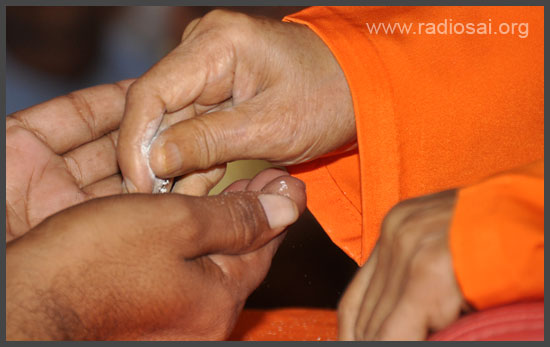 |
|
The panacea for all ills - worldly and other-worldly |
Vibhuti also gains special interest and meaning for the devotees of Bhagawan Sri Sathya Sai Baba. Right from His childhood days, ever since He declared His Avatarhood, Baba materialized vibhuti from the thin air and prescribed it for all kinds of maladies and as all kinds of blessings - worldly and spiritual. The Vibhuti that He gave was of innumerable kinds, suited to the different purposes for which it was created. Sometimes it was in the shape of a hard cube, though more often it was a powder - fine, grainy or flaky. It could be fragrant or pungent, salty or sweet or, sometimes, absolutely tasteless. In colour, it was white or blackish, or of any of the intermediate shades. Sometimes, when He waved His Hand, vibhuti materialized - container and all! Such is Baba’s association with vibhuti that His biographer, Prof. N. Kasturi, dedicated an entire chapter entitled, “The wave of the Hand” to record it.
In fact, Swami has elevated Vibhuti into a sort of 'identity card' for a Sai-devotee. In a verse which He sings in His melodious voice, He proclaims:
Kolanuku Kaluvaye Shringaaramu
Aakashamunaku Chandrude Shringaaramu
Samudramunaku Alale Shringaaramu
Swami Bhaktulaku Vibhutiye Shringaaramu
(Lotuses are the ornaments for the lake. The moon is the decoration for the skies. The waves decorate the ocean. Similarly, vibhuti is the ornament for Swami’s devotees.)
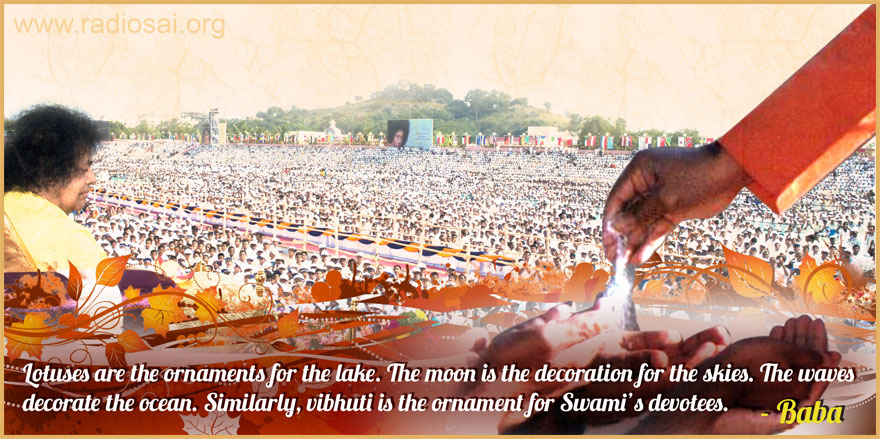 |
So, it is not surprising that during some festivals like Dasara and Mahashivarathri, Swami would manifest and distribute copious amounts of vibhuti. The video below will give a glimpse of one such magnificent happening - materialization and distribution - during the Vijayadashami day of Dasara.
Vibhuti today, has become the Mahaprasadam (gracious gift given to all devotees as a token of blessings from the Master) in any gathering - local or international - which takes place in the name of Bhagawan Sri Sathya Sai Baba.
Getting to Know the Vibhuti ‘HIS’tory
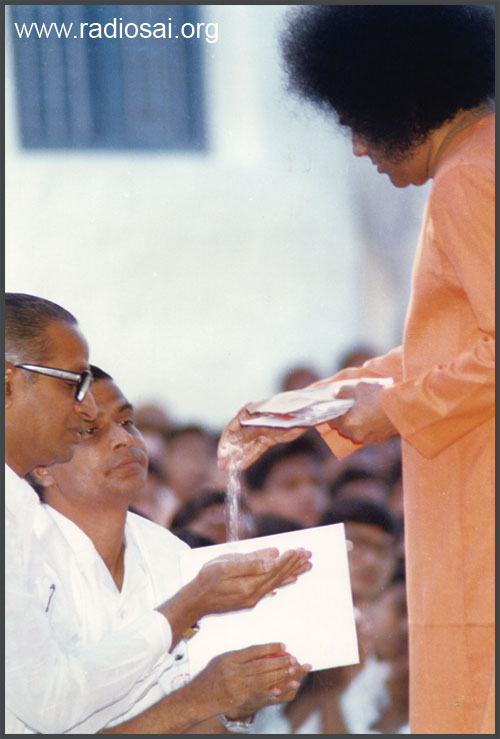 |
|
Even the vibhuti that was first 'manufactured' was done so directly by the Divine Hands. |
Ever since the erection of the Prasanthi Nilayam ashram, the crowds that gathered in Puttaparthi only kept increasing. Puttaparthi became a pilgrimage centre for people of all religions and regions of the world. It was only apt that something as universal as ash became the Prasad that the devotees sought in this Universal abode of Supreme Peace. The 'lucky ones' got vibhuti materialized with the divine wave of the palm. But everyone wanted a pinch of the holy ash for themselves and also some to carry back home as a token of Baba’s blessings. That was when Swami personally instituted a procedure for the ‘manufacture’ of vibhuti.
Legend goes that Swami Himself gathered and cleaned cow-dung, had it dried and burnt to ashes. These ashes were sieved and finely powdered to result in the first edition of the vibhuti from Puttaparthi. One small paper packet of this ash was available for any visitor to the ashram to seek before leaving for his or her hometown. It was some time in the 1980s that Mr. Khialdas, the person entrusted with taking care of the co-operative general stores for the welfare of devotees, approached Swami with a request. He told Swami that devotees were wanting to take away huge quantities of vibhuti to their respective countries and hometowns. There was no way that the little vibhuti being 'manufactured' would suffice to fulfil even part of the demand. He thus sought Swami’s blessings for setting up an elaborate vibhuti manufacturing system after which the same could be sold at a very low cost. The time had arrived for the Sai mission of Love to change gears and Bhagawan Baba graciously permitted the venture.
A little detour to explain the twofold purpose of this article is relevant here. There is a mistaken notion among many that all the vibhuti that they purchase in the ashram (at Rs 2/- per 100gms-packet) has been 'materialized' by Swami and stored in huge chamber for distribution via such packets. Of course, the vibhuti has been 'created' by Swami in the same sense that the Universe has been created by Him; you and me have been created by Him. But just as the Big Bang was the Lord’s instrument of Universe-creation and the parents are His instruments for getting us into the world, there is an instrumental-process that pours forth the Divine vibhuti too.
The first purpose of the article is to educate the reader about the know-how and details of this process. The second purpose is to elaborately answer the question - 'now-how' is the vibhuti made?
Ever since Swami agreed to the manufacture and sale of vibhuti in 1986, the raw ash has been procured from a manufacturer and supplier in Palani, Tamil Nadu. This raw vibhuti is constituted majorly from husk-ash with trace quantities of cow dung-ash (less than 1%). This ash arrives to Prasanthi Nilayam, packed in 50kg bags. The labour of love then begins wherein four different perfumes are mixed into the vibhuti in proportions gifted by Swami to a certain lady, Bujamma by name.
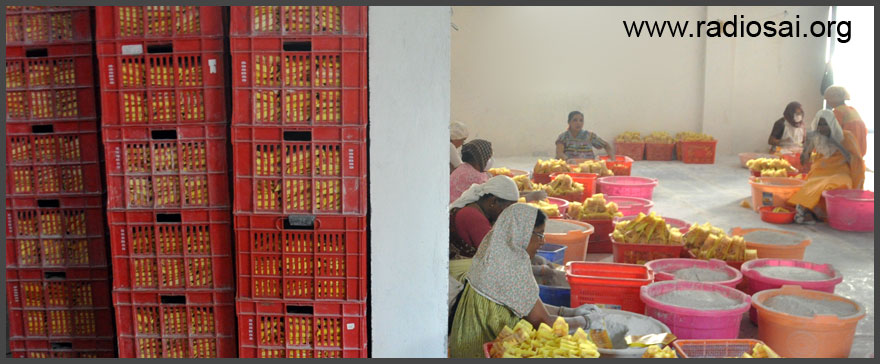 |
A wall in the 'manufacturing' shed separates the works-in-progress from the packaged 'good(s)'. |
Two solid perfumes and two liquid perfumes were selected from among dozens brought to Swami by Khialdas. Swami called Bujamma and instructed her to mix a few tablespoons each of the liquid perfumes and a few tablespoons each of the solid perfumes into 40 bags of unscented vibhuti that arrived from Palani. (The exact measures are withheld. The exact formulation is a secret that is as guarded as the famous ‘Coke formula’. The formulation is transferred only by word of mouth and is not written down anywhere.) That makes a total of a few grams of perfume into 2000 kgs of vibhuti. The phrase ‘a few grams’ is correct because even today, the same spoons are used to add the perfumes. Electronic balances are not used for the proportion!
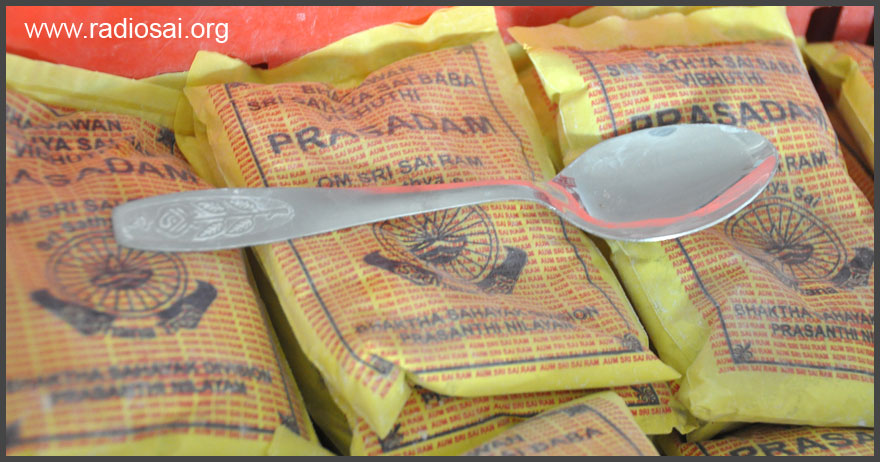 |
The blessed spoon that is used to this day to measure the various perfumes to deliver the 'perfect' formula. |
Bujjamma was entrusted with the sacred duty of mixing the perfumes into the vibhuti in the prescribed proportion. With the help of a few male workers, she would sincerely and conscientiously go about her daily sadhana of ‘creating’ vibhuti. The mixing needed to be thorough and that would itself take several hours. Once mixing was complete, the arduous task of packing had to be completed before the vibhuti packets were ready for the devotees.
One day, Bujjamma was told by Khialdas and several others that the vibhuti was not fragrant enough. Could she add a little extra perfume? As she mulled over this suggestion, her Lord visited her in a dream. There, He strictly warned her against increasing the given proportion. On the other hand, He told her to actually reduce the solid perfume to just half of the original prescription for the 40 bags of vibhuti. The divinely commanded change was incorporated and the proportions have remained the same ever since.
The ‘Now-How’ of the Vibhuti-Making Process
Curious to know more about the ‘Swami-approved’ and ‘Swami-gifted’ method of vibhuti manufacture, I wended my way to the massive shopping complex of the Sri Sathya Sai Bhakta Sahayak Sangh in Prasanthi Nilayam. In a corner of the ground floor were huge trays stacked with 100-gm packets of the holy ash. I approached Mr. Doraiswamy, who is taking care of the vibhuti-manufacture in Prasanthi Nilayam. The details that he shared with me were mind-blowing.
Can you make a guesstimate of the amount of vibhuti that is disbursed in a year from Prasanthi Nilayam? Really, stop reading now, close your eyes and make a rough estimate. When I did this, I thought that the stores might possibly be selling about 5,000 kilograms of vibhuti a year. The actual number left me dumbfounded. On an average, about 100 metric tonnes of vibhuti is disbursed every year - a solid 100,000 kilograms! In fact, in 2010, this figure was a whopping 128 metric tonnes! And this entire amount is completely prepared by voluntary staff which averages 20 women!
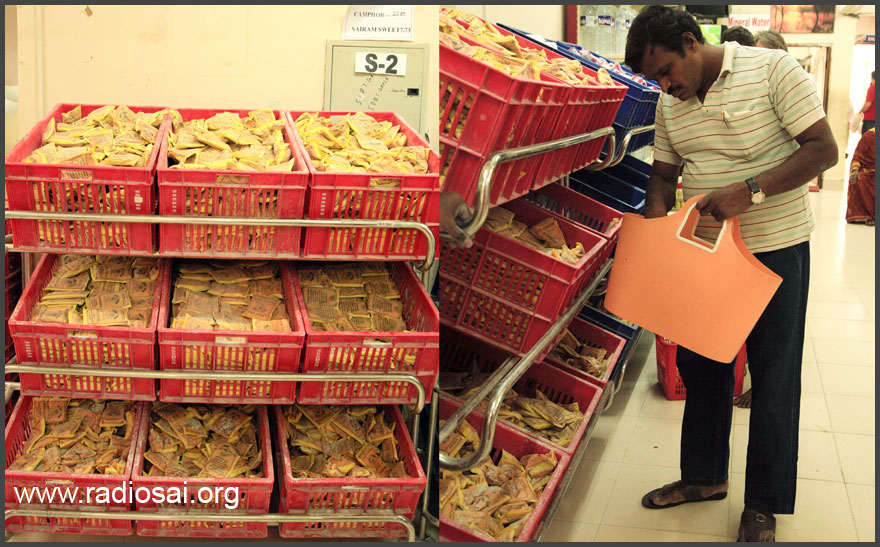 |
The section of the stores in Prasanthi Nilayam that earns no money but infinite blessings and good wishes of the devotees! |
That naturally spurred in me the desire to visit the shed which is currently being used as the site for this manufacture. Even as I neared the shed behind the accommodation blocks on the North side of the ashram, the fragrance of the holy ash wafted into my being. I felt so surcharged. Entering the shed, I saw that there were about 15-20 women, silently and efficiently going about their task of packing the vibhuti. One or two of them raised their heads to see who was the newcomer silhouetted at the door. The others did not even notice my presence. I pulled out my camera and flashed aloud my entry. Now, a few of them looked at me and I asked aloud,
“Can I speak to Sanku Ramaniyamma?”
“I am here”, said a lady in her early fifties, sealing the yellow vibhuti packets. I walked up to her and introduced myself. Hearing that I had come to listen to the vibhuti story, her eyes sparkled.
“What shall I tell you? You have come 2 years too late! Bujjamma has left for her hometown because of her advanced age. She would have definitely narrated hundreds of stories related to the vibhuti manufacture!”
“You mean to say that till 2012 it was still Bujjamma who did the vibhuti mixing?”
 |
The mountain of the mixed vibhuti which exits the machine is sealed into yellow, plastic packets and stored in trays. |
“Yes! When the demand for vibhuti became very high, a machine was brought. But even then, it was Bujjamma who maintained the proportions of the perfumes in the vibhuti. She taught me how to do it, saying that she would be gone for a few months of ‘vacation’. We came to know later that she would not be returning.”
Then, Ramaniyamma gave a detailed description of how the process takes place. A truck arrives once or twice a month from Palani with the raw vibhuti and unloads the sacks at the unloading bay of the shed. Ramaniyamma takes a tub full of vibhuti and adds the perfumes in their respective ‘spooned’ proportions. The vibhuti in the tub is thoroughly mixed along with chanting of the spiritual hymns and mantras (no fixed ones though). This ‘concentrated’ vibhuti is now equally distributed into 40 small bags. A worker, Ratnakar by name, who has been in the ‘manufacturing facility’ for the past 40 years, then adds a sackful of raw vibhuti into the mixing machine. To this, he adds one small bag of the ‘concentrated’ vibhuti. Over the next hour, the machine mixes and drops the vibhuti which is ready for use. This vibhuti is transported in huge vessels to the packing area which is separated from the machine room by a wall.
The Evolution of the Vibhuti Packaging
There are about ten ladies who, through sheer experience, place approximately 100 gms of vibhuti into yellow packets. These packets pass through the ‘balancers’ who place each packet on a weighing balance and remove/add vibhuti to total an exact 100 gms. These ladies then pass on the packets to the ‘sealers’ who press an electric handle to seal the packets. The Divine prasadam is ready to reach the devotee now.
 |
The Lord's helpers at work, ensuring that the most recognized signs of Swami's grace reaches every devotee's home in every corner of the globe. |
However, this process of packaging has also evolved over two decades now. In 1986, the original packaging involved a yellow paper cover into which the vibhuti would get filled. To prevent moisture from making the ash soggy, the paper packet would then be covered in a yellow-coloured, transparent plastic sheet. This would then be tied with a thin, white twine. This elaborate packaging was very labour-intensive.
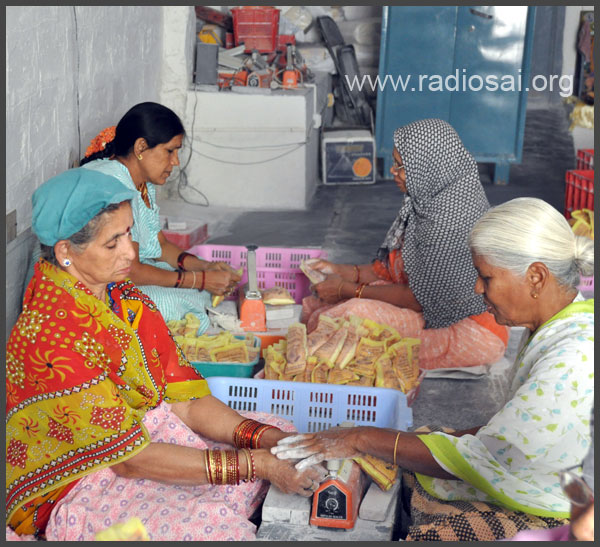 |
|
Ramaniyamma (in the background in light blue), apart from mixing the vibhuti, works with the electric-press sealing section too. |
In 1994, Swami spent almost 8 months staying at the Brindavan ashram in Whitefield, Bangalore. Naturally, the crowds in Brindavan were much more compared to those in Puttaparthi during that time. That was the time when, with Swami’s permission, Mr. Ruchir Desai (faculty at the Brindavan Campus and who till date manages the co-operative stores in Brindavan) started the manufacture of vibhuti at the Brindavan ashram as well. This was essential to meet the ever-increasing demand for vibhuti from the devotees. With great difficulty Ruchir Desai obtained the formula from Bujjamma. Bujjamma gave the formulation only after receiving confirmation that Swami had indeed instructed him to start vibhuti-making at Bangalore. On some days, more than a 1000 packets would be sold in a matter of hours and even shifting of the manufacturing process did not seem to solve the problem of heightened demand. The bottleneck for production was the packing process. In a bid to increase production to meet the growing demand from devotees and clear this bottleneck, Ruchir Desai approached Swami.
He informed Swami about the existing packing method and sought blessings for a new packing method. Printed plastic covers were obtained which could be instantly sealed with a hot electric press. Swami selected the suitable design for the cover and also gave instructions on what should be printed on the cover. Thus, the modern packaging that we see today came into existence, again with blessings and permission from Swami.
A Real Labour of Love
Ramaniyamma and her dedicated team of volunteers consider it a great blessing to be able to pack the greatest treasure on earth - vibhuti! They were once offered salaries for the 5-6 hours of hard labour they put in on a daily basis - without weekends, without vacations - but they flatly refused.
“This is something we wish to do for Swami. How can we accept money for it?”
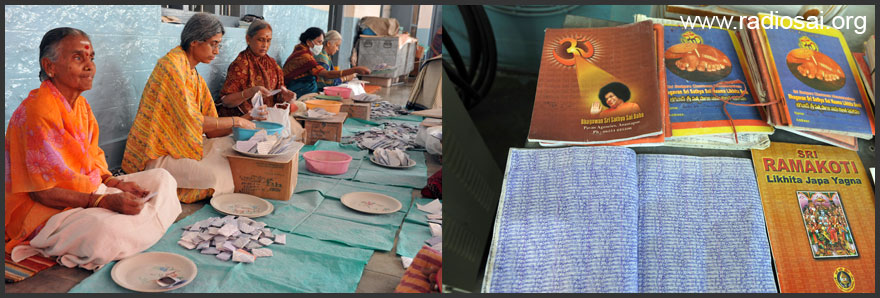 |
It is with His name on their lips that these selfless volunteers silently go about their great service (left). Likhita Japam books from the world over land in Prasanthi to offer their leaves as covers for the vibhuti. (right) |
The same is the story in Brindavan too, with the volunteer team there being headed by Mrs. Bhutia.
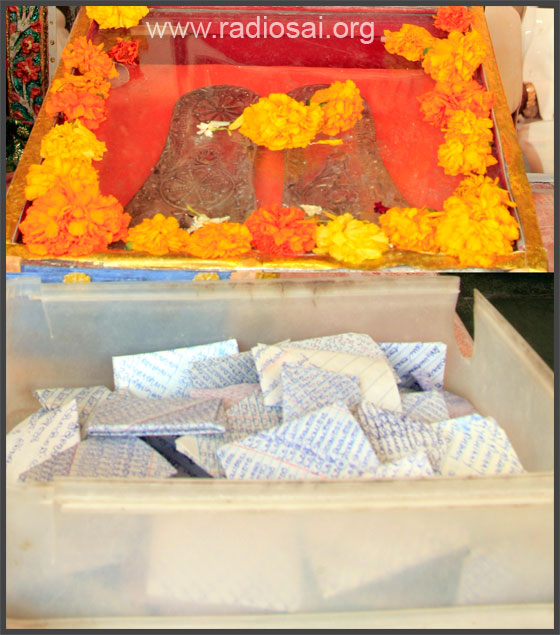 |
|
Wrapped in paper with His name, charged with the chanting of His name and ready to spread the glory of His name. |
These apart, there is need for a separate team to make vibhuti packets that are made available as prasadam for every devotee visiting the ashram, either in the PRO office, security office or accommodation office. This separate team is constituted by very elderly ladies, some of them even in their eighties, who sit during and after the bhajans, packing vibhuti. Like the volunteers who are involved in the large scale manufacture and packing, these ladies too seek nothing but His Love for their efforts. They can be seen silently doing their activity behind the bhajan hall in Prasanthi Nilayam, making small packets. These are 10 gms packets which are made from the pages of the 'Likhita Nama Japa Sadhana' books. These books hold the divine name, written thousands of times over, by devotees as part of their sadhana or spiritual practice. Once the book is complete, it travels to the ashrams where it gets transformed into the holder and carrier of the sacred ash.
That, in brief, is the story of the vibhuti-manufacture. Though a lot of detail has been presented here one detail has been left out. And that is not because it was forgotten; it was more because it was taken for granted that everyone knows it. The most important ingredient of the vibhuti is the infinite Love and Grace of Bhagawan Baba that it always contains!
The story of vibhuti-manufacture has many more experiences and narratives embedded in it and one article will never be sufficient to capture all that glory. But if any reader is keen to know these most fascinating tales, the best way would be to join this dedicated team and volunteer to pack the vibhuti when you are at Prasanthi Nilayam or Brindavan. That would be a win-win situation. You will get fascinating stories and a chance to be part of this magnificently divine process of making the mahaprasadam. The volunteer team manufacturing the vibhuti will get much-needed help in increasing their productivity to meet the burgeoning vibhuti-need worldwide.
Those that wish to offer themselves in this labour of love may kindly contact the PRO (Mr. Murali) of the ashram at Prasanthi Nilayam. Those that wish to do the same at the Whitefield ashram may contact Mr. Ruchir Desai.
Paramam Pavitram Baba Vibhutim
Paramam Vichitram Leelaa Vibhutim
Paramaartha Ishtaartha Moksha Pradaanam
Baba Vibhutim Idam Aashrayaami
- Aravind Balasubramanya
Graphics - Mohan Dora
If you have any feedback, you can write to h2h@radiosai.org.
Do not forget to mention your name and country.






